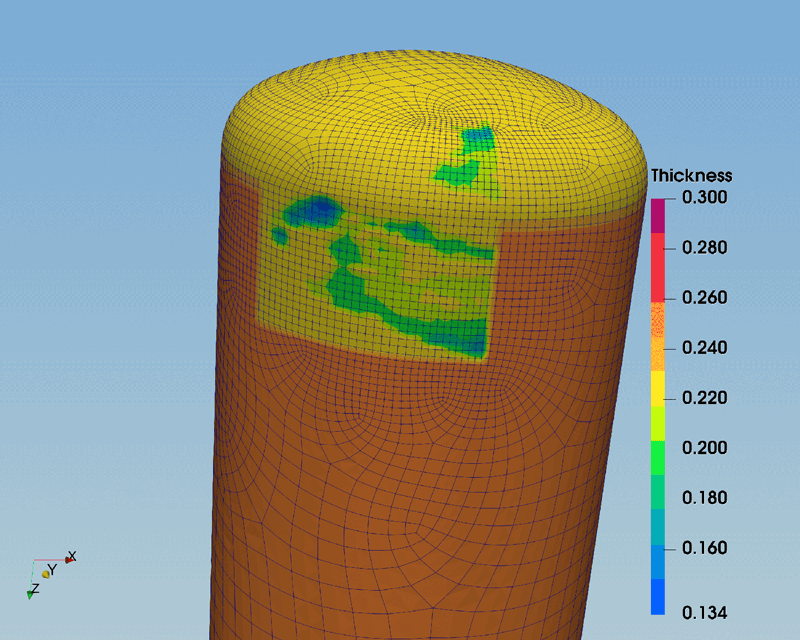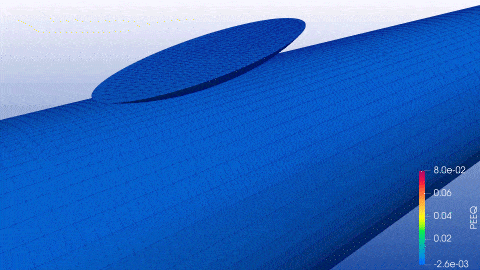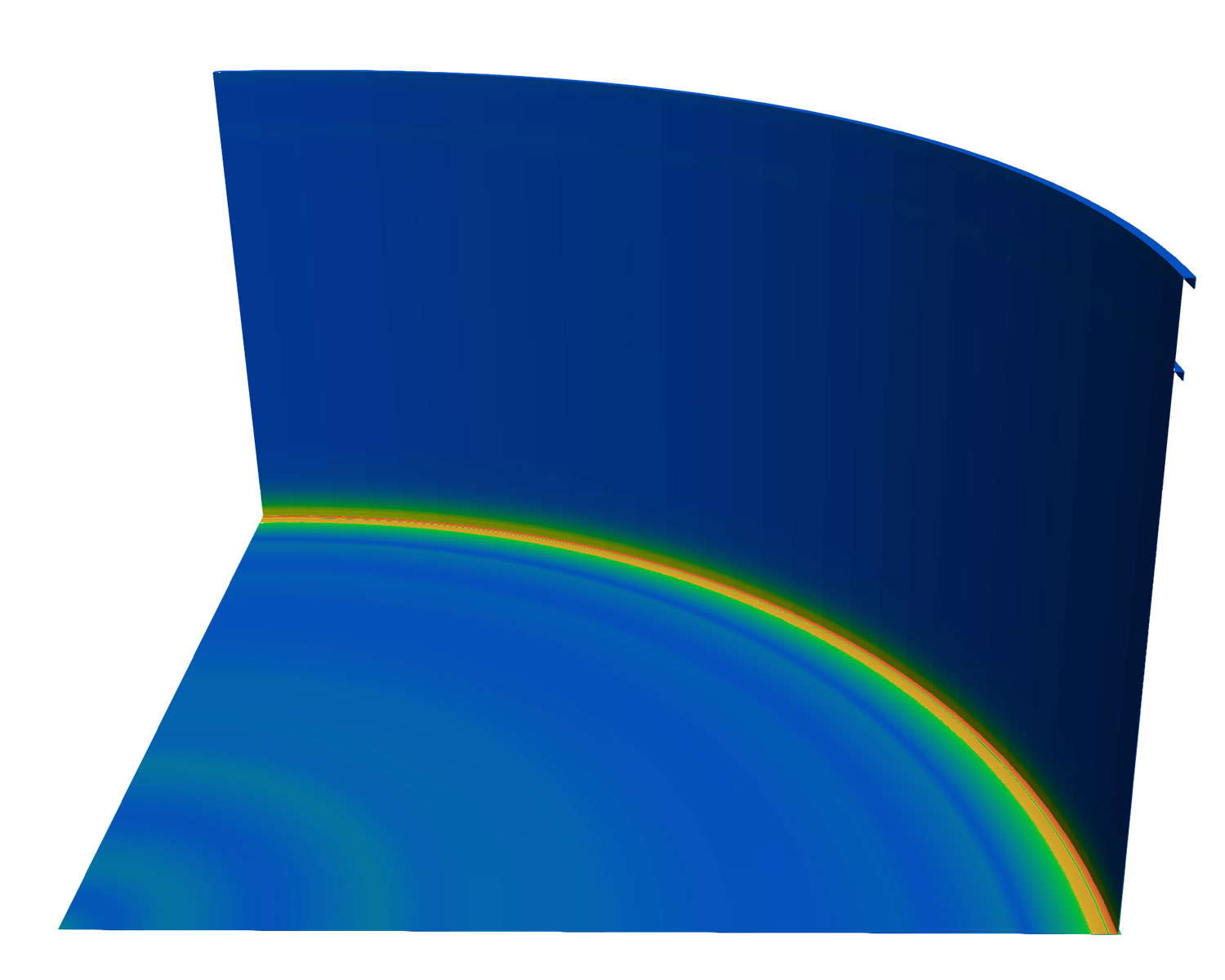
Automated Finite Element Analysis Tools
Equity Software has cloud-native finite element analysis (FEA) webtools that automate tank settlement, pipeline dents, and local thin area analyses.
Download the Automated FEA Overview here.
Finite Element Analysis Made Easy
Automated FEA at Your Fingertips
Integrating finite element analysis (FEA) into a fitness-for-service (FFS) assessment doesn’t need to be expensive or time-consuming any longer.
Equity Software is changing the game with automated FEA webtools that use the cloud to deliver an efficient, comprehensive, and more cost-effective solution for modern asset management. As leaders in FFS technology, we have integrated our knowledge into these cloud-native tools to help you use advanced Level 3 analysis at your plant to extend equipment life and safely justify continued operation.


Faster FEA Assessments
- Complete weeks of engineering work in less than an hour
- Build a detailed 3D finite element model in minutes
- Use automated post-processing and integrated 3D visualization

No Expertise Required
- No FEA knowledge required!
- Enter geometry, data, or dimensions to get started
- Conduct Level 3 FFS assessments with the ease of Level 2

Flexible & Scalable Licenses
- Always have access to the latest features & functionality
- Add new licenses or modules as needed
- Get started without lengthy IT set-up

Nozzles
Evaluates the structural integrity of nozzle connections on pressure vessels to estimate the stresses at nozzle-to-shell junctions.

Local Thin Areas
Determine if thin areas are fit for service by evaluating the structural weaknesses to ensure operational reliability and regulatory compliance.

Dents
Prioritize repairs based on the severity of the dents by evaluating strain, damage, and the remaining life of dents.

Tanks
Quickly perform an advanced stress and strain analysis, evaluate local failure or global collapse, and conduct critical flaw screening.
Why Choose Equity Software?
These powerful tools are the result of direct client feedback and more than eight years of rigorous research. These tools handle the complexities of FEA with ease.
- Dedicated to developing cloud-native asset management tools
- Automated model building, mesh generation, analysis, and post-processing
- Extensive geometry modeling accounts for variety of equipment and components
- Distributed cloud computing accelerates results while reducing costs
- 3D visualization with key simulation results
- Post-processing performed to latest editions of API 579 and ASME BPVC VIII-2
- Conduct FEA without using Abaqus! All tools are verified against Abaqus

Modernize Nozzle Designs: Nozzle FEA
In a typical facility, nozzle connections handle a complex combination of loads, including internal pressure, external piping forces, thermal expansion, and equipment weight.
Nozzle FEA provides fast, accurate, and code-compliant stress analysis for nozzle-to-shell connections in pressure vessels. Using Equity’s extensive knowledge of nozzle design and fitness-for-service (FFS), the webtool automates model (mesh) generation, analysis, and post-processing based on ASME standards.
Fast
Automate model creation and analysis to reduce engineering hours.
Accessible
Optimize design and FFS assessments with detailed stress results and 3D visualization.
Accurate
Meet API/ASME code requirements for nozzle design, local stress analysis, and FFS assessments.
Simplify Corrosion Analysis: Local Thin Area FEA
A question of structural integrity in pipelines and pressure vessels is often caused by local corrosion damage. If you rely on a Level 1 or Level 2 FFS assessment, you may conduct unnecessary and costly repairs, maintenance, or replacements.
The Local Thin Area (LTA) webtool delivers the accuracy of FEA to help you avoid expensive repairs by automating everything from model generation to stress assessments. Use this webtool to make highly accurate evaluations accessible to a wider range of users and seamlessly integrate with other Level 2 assessment tools developed by Equity Software.
Fast
Perform tedious tasks in seconds and avoid expensive equipment repairs
Versatile
Analyze general and local corrosion of cylinders, elbows, cones, and heads with minimal input
Precise
Use a solver benchmarked and verified against Abaqus


Transform Pipeline Dent Analysis: Dent FEA
Dents in pipelines, caused by external impacts or natural forces, can compromise the structural integrity of these assets. Assessing these dents accurately and efficiently is essential for maintaining safety and compliance.
Dent FEA is a cutting-edge, cloud-native webtool specifically designed to tackle one of the pipeline industry’s most challenging issues—dent analysis—by measuring strain and damage in dented pipelines and estimating fatigue life. Use Dent FEA to improve operational efficiency, reduce downtime, and prevent costly failures.
Effective
Achieve more accurate results for better maintenance planning and prioritization
Precise
Meet 49 CFR 192.712(c) requirements with Level 3 FEA assessments according to API RP 1183 and API 579
Fast
Evaluate up to 100 dents per hour, reducing analysis time by over 90%
Protect Aboveground Tank Safety: Tank FEA
It is critical to promptly assess the bottom settlement in an aboveground storage tank and determine structural integrity and operational safety.
The Tank FEA webtool is a fast, reliable, and systematic way to assess edge settlement issues and ensure the longevity and safety of your storage tanks. This easy-to-use webtool delivers advanced stress assessments through automated axisymmetric FEA, ensuring compliance with API 653 while also addressing safety-critical flaws like ratcheting, collapse, and local damage. Use Tank FEA to help you reduce downtime and preserve tank safety.
Effective
Reduce analysis time and decrease costs for unnecessary tank repairs or maintenance
Accurate
Evaluate global and local failure criteria for more accurate maintenance decisions
Fast
Automatically generate FEA models according to the latest API 653, API 579, and ASME BPVC VIII-2

More FEA Tools Coming Soon!

Our development team is focused on expanding our FEA tools to include:
- Nozzles (Design and FFS)
- Coke Drum Bulging
- Header Box Nozzles
- Sphere Leg Attachments
- And many more!
Contact Equity Software for a demo.
Our Software Experts
The groundwork for Equity Software began more than 30 years ago with the initial development of SagePlusTM. Over the years, Equity Software has continued to introduce industry-leading innovations, including SagePlus, API RBI, the Equity Engineering Cloud (eec®), and damage mechanism software.
We’ve integrated these advancements into the PlantManager 6.0 platform, embracing the future of cloud-native solutions. Our ongoing commitment to innovation and collaboration continues to drive our mission in advancing industrial asset management and technology.
- Pioneered development of RBI and FFS software
- Integrated API and ASME codes and standards into all software
- Used by Equity’s consulting engineers for FFS, RBI, damage mechanism reviews, and other asset lifecycle management projects
Team Spotlight
-
Betul Abay
Staff QA Tester I
